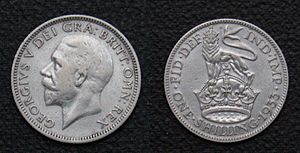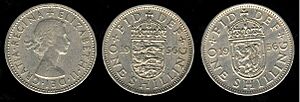Shilling facts for kids
The shilling was a type of currency used in many countries, especially those connected to the British Commonwealth. It was a common coin for a long time. People sometimes called a shilling a "bob."
Contents
What is a Shilling?
A shilling was a coin that represented a certain value of money. It was used in places like the United Kingdom and many countries that were once part of the British Empire. Even today, some countries in Africa still use currencies called shillings.
Where Did the Name Come From?
The word "shilling" comes from a very old word, scilling. This word was used by the Anglo-Saxons long ago. Back then, it was a way to measure value. For example, in one area, it might have been worth a cow, and in other places, it was worth a sheep! The word itself might come from an even older word meaning "to ring" or "to resound."
How Was It Written?
The short way to write shilling was "s," which came from the Latin word solidus. This was the name of an ancient Roman coin.
Sometimes, people used a slash to show shillings and pence. For example, "1/6" meant one shilling and sixpence. You would say this as "one and six." If there were no pence, it would be written as "11/-". In some parts of Africa, the abbreviation "sh" is used today.
How Much Did It Weigh?
In 1816, a big change happened with British coins. The mint, which makes coins, was told to make 66 shillings from one troy pound of sterling silver. This meant each shilling had a specific weight. This weight was about 5.655 grams. This weight stayed the same for a long time, even when the shilling was replaced by the "5 new pence" coin in 1971.
Images for kids
-
Schilling coin of the imperial city of Zürich, minted in billon, 1640
-
Silver 4 schilling coin, Hamburg, 1728
-
Shilling, UK, queen Victoria, 1853. Silver, weight 5.64 g.
-
The price tag on the Hatter's hat reads '10/6'
-
Because of the British Empire, the shilling was once used all over the world. This two-shilling piece was made for British West Africa.
-
Countries in Africa where the currency is called shilling.











